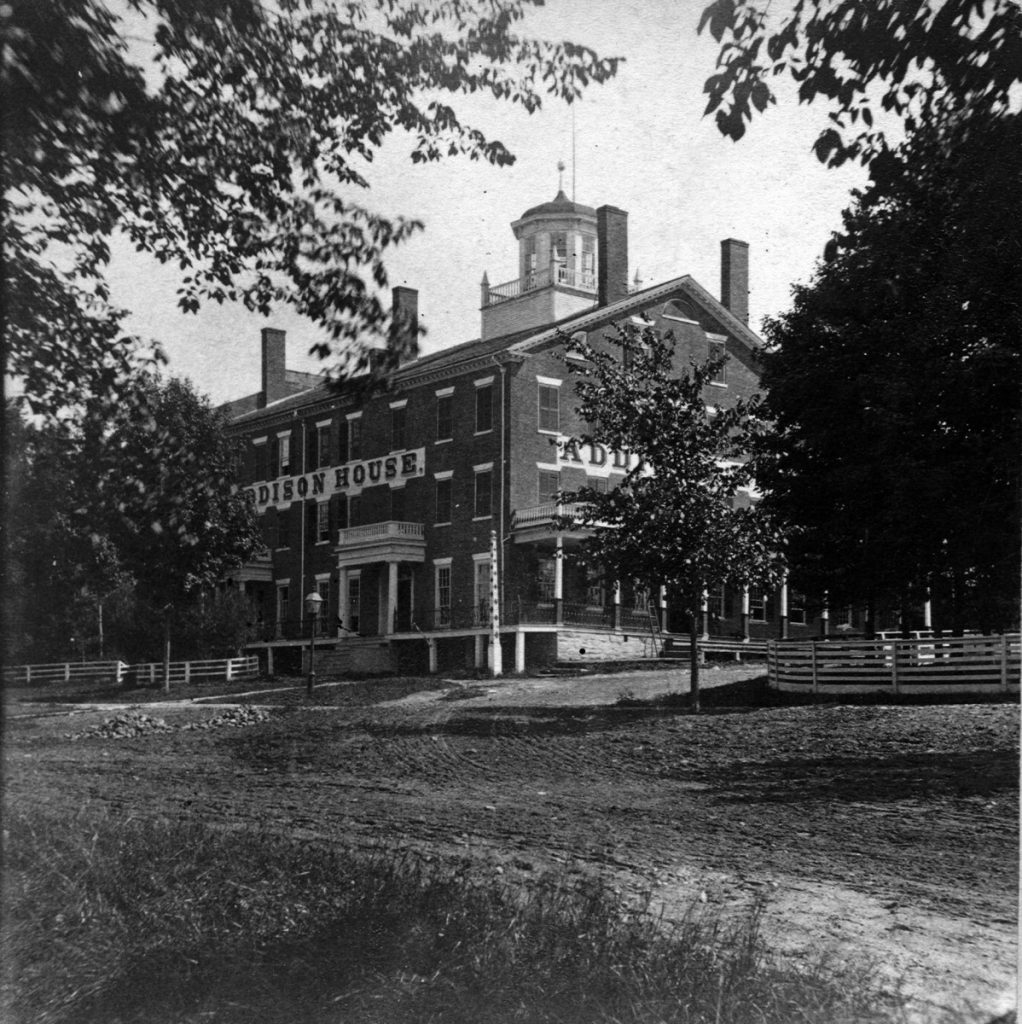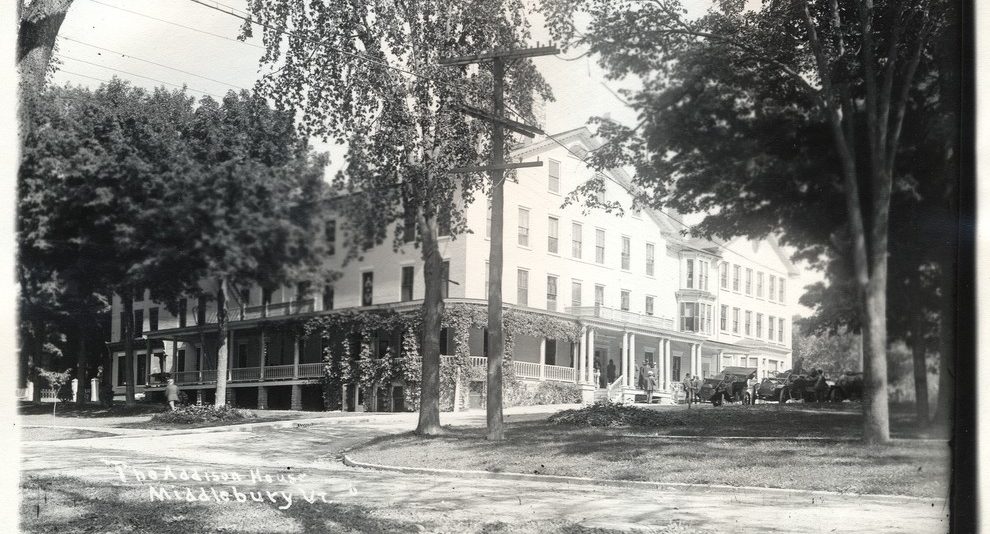15 Court Square Formed in 1785, Addison County had, at first, no permanent county seat. West Addison near Lake Champlain, the first proclaimed site for court sessions, looked like a prime contender, though Middlebury was certainly more centrally located. Soon after deciding to move to his property at Middlebury Falls, the canny Painter decided to tip the scales a little in favor of his intended town. He deeded a lot, just north of his own house and fronting on the line of Pleasant Street, to the County, and his persuasion seems to have worked. In 1790 Middlebury was proclaimed shire town of the County.
The first construction in the area now known as Court Square was a wooden jail built in 1794 (moved in 1812 to 5 Washington Street and subsequently remodeled as a residence and law offices). In 1796 work began on the courthouse itself. Not elaborate, it was nonetheless an impressive structure for the newly settled region. Without, it was a large, simple two-story block with a belfry and fan (text with tooltip) an arched window with radiating muntins, often above a door window in its gable as its only embellishments. Within, it had one large room with a coved (text with tooltip) concavely curved ceiling, a sloping floor with benches and a rear gallery. Noble but Spartan, it was reputedly very uncomfortable and cold, and the court preferred to continue meeting in an adjacent tavern. Not that the courthouse wasn’t used. The state legislature met there in 1800 and 1806. In 1800, as well, Miss Ida Strong opened her female seminary, the feminine counterpart to the Addison County Grammar School, in the cold courthouse. The Congregational Society was a regular user of the hall until their church across the green was completed in 1809, and the Episcopal Society met there from 1810–1815. In 1804 it was the locus of an important event in the history of abolition law. Presiding judge Theophilus Harrington of Clarendon was confronted by a New York slave owner who was suing for the return of a fugitive slave. When the owner’s attorney presented the court with a bill of sale to support the plaintiff’s claim, Harrington ruled he would not return the fugitive for anything less than “a bill of sale signed by God Almighty Himself.”
Another of Painter’s schemes for Middlebury ran counter to the placement of the courthouse, however. This was the development of the Center Turnpike, a stage route down what is now the line of Highway 7 to East Middlebury, across Middlebury Gap, and on to Woodstock, where it connected with stages to Boston. Begun in 1799, the new road entered the village on what is now Court Street and terminated at the back side of the courthouse. Accordingly, the building was moved across the street onto more Painter-donated land in 1814, and its old site became Court Square. In 1829 the building was divided into two more-heatable floors, the upper continuing as a courtroom, the lower serving as town hall. Repaired and remodeled in 1844, it was determined inadequate and old fashioned in 1882 and moved to the Addison County Fair Grounds (now the recreation park) down Court Street, where it served variously as a harness shop and floral hall until it was torn down in 1939.


Its replacement, by Clinton Smith of Middlebury, was described in the Middlebury Register in 1883 as of “mixed architecture with Queen Anne features,” and declared the handsomest courthouse in the state. 15a The facade is both picturesque and ordered. Its asymmetric massing and variety of detail in stone, brick, wood, slate, and glazing are held in line by articulating brick panels and “structure.” This was very up-to-date design for Vermont. The panel-brick style (as it since has been dubbed) was just being popularized by leading architects in Boston, New York, and Philadelphia. Yet the courthouse is hardly a pure import. Its architect is local, and he has put the stamp of his personality and craftsmanship on its design. He also has maintained a sensitivity to its setting. Vigorous in its detail, the courthouse remains a good neighbor to the earlier structures on Court Square, prominent, but not too assertive for the good of its surroundings.

Among its neighbors, the house to its right with the elaborate center chimney was built in 1825; the Masonic Hall to its left was built in 1823. By the 1990s, the 1883 courthouse was considered to be inadequate and a new courthouse, named after Judge Frank Mahady, was constructed in 1995–1996 on a more spacious site behind the previous one. The new building features a hipped roof, (text with tooltip) a roof with sloped rather than vertical ends a central cupola and a pedimented (text with tooltip) pediment: a low-pitched gable defined to read as a triangle by cornices or moldings entry bay and houses the original courthouse bell in its lobby. The old courthouse, no longer used by the court system, passed to the ownership of Middlebury College in accordance with provisions in Painter’s deed.

16 Middlebury Inn On the north side of Court Square and serving as a focus for travelers entering the town on the old Centre Turnpike (Court Street) is the Middlebury Inn. Painter had deeded this prime site just north of the court lot to Simeon Dudley in September of 1788 for the construction of a tavern, but Dudley did not carry through. In 1794 Samuel Mattocks did, however, building a tavern that stood on the site until a fire destroyed it and neighboring structures in 1816. The brick house of Nathan Wood (on the Town Hall Theater site) served as an interim tavern until Wood rebuilt on Mattock’s lot in 1826. Wood’s new inn, the Vermont House, was a grand three-story brick building with fifty rooms. Since its opening on April 16, 1827, the inn has changed its name twice (Vermont House 1827–1852; Addison House 1852–1927; Middlebury Inn 1927–present), been Victorianized and un-Victorianized (1851, 1865, 1897, 1927), and grown considerably. Once it had a cupola, later a wrap-around piazza, (text with tooltip) the name given to the large porches of the later 19th century because of their similarity to the arcades and colonnades which often surround an Italian square (or piazza) and later still was painted yellow. Indeed, perhaps the only bit of the original building other than the basic masonry of the main block to survive all the changes is the fan-lighted (text with tooltip) fan light: an arched window with radiating muntins, often above a door doorway with elliptical carved decorations looking out onto Pleasant Street and the Green. The basement and part of the first floor have housed at times offices, stores, a barber shop, and the Middlebury Post Office. For all the changes, however, the building has a continuous history of service to the town as its principal inn and a favorite meeting spot since Nathan Wood’s day.


